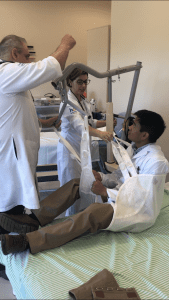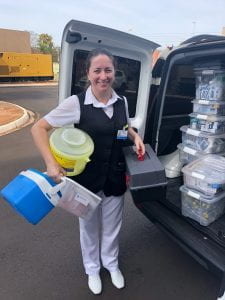As a bioengineering student, my two favorite things are creating devices and talking to clients/patients. This week, I was able to do both! We began with a visit to the Palliative Care Unit to see first-hand the problems mentioned by Dr. Luis in our meeting last week.
- Portable patient records — Domiciliary visits are a huge part of Hospital de Amor’s promise of universerval healthcare. Mobile units travel to a handful of the surrounding 18 regions each day to treat patients with varying conditions. While this method of treatment and outreach has proven to be very successful for patient health, transporting paper copies medical records from each patient can be a delicate matter and it also takes up valuable space in a small van. Dr. Luis asked if Rice students might be able to combine the need for condensing van space with the need of digitizing medical records, making them accessible even in the most remote locations in the region. The hospital is actually undergoing a huge push to digitize medical records but it will take about a year or two until the thousands of reports and images all make it onto a secure database. In the meantime, we proposed the idea of installing a small computer and encouraging medical teams to upload patient records onto a flashdrive in order to access them freely without the need of wifi. Dr. Luis seemed super keen on the idea but I would love to pitch this concept back to Rice 360 engineers for further investigation.
- “Patient Crane” — (I’m sure the actual device has a more elegant name. Excuse the oversimplification.) Many patients in the palliative care unit undergo physical therapy. Sometimes in the beginning stages, however, patients are unable to support themselves to move from their treatment bed to a wheelchair and vice versa. In order to address this problem, the physical therapy department uses a large device that lifts the patient in a mesh basket from one area to another. The device can hold up to 130 kg (~287 lbs) and has wheels which allow physical therapists to transport the patient. Unfortunately, the technology is not very comfortable to individuals with femur fractures which we learned are quite common. Nurse Adrianna demonstrated the apparatus on Matthew, a Rice GMI intern, in order for us to get a better idea of its function and the type of stress and pressure the body endures while suspended by the net. Nurse Addrianna asked that we create a new basket attachment capable of supporting a patient with femoral fractures. The product should be portable, reusable, easily cleaned, durable, and successfully immobilize the patient’s legs.
I felt like the given ideas were super interesting and could serve as great project ideas for Rice undergraduate students! Of the two potential problems, however, I was especially drawn to the physical therapy device, the patient crane. Each condition and injury is slightly different. As such, I believe that devices should reflect those intricacies while also being applicable to a variety of patients with similar conditions. That is the challenge! I would love to pitch this idea back to Rice undergraduate and maybe even work on it myself as a personal project when I return!
On Tuesday afternoon, we enjoyed a tour of a mobile unit. The team of nurses and doctors had completed a full trip to about five surrounding regions for domiciliary visits. Despite a full day in a small, packed van with little-to-no-AC, Nurse Landina welcomed us with open arms and a couple of jokes. The main problem with the mobile units is the lack of space and inefficient storage. Currently, teams store equipment (IV bags, bandages, syringes, etc.) in plastic containers filled to the brim. This method gives a place to each tool, however, the use of various containers of different sizes proves to be a nightmare when unloading and reloading the van with each house visit. Nurse Landina noted that she and her teammates have to carry about five heavy bins with them to the house with each visit and go back to the van to grab the remaining supplied. Because each patient is different and might require an array of medication and treatment, the van comes packed with any and all types of tools. Sometimes, according to Nurse Landina, the van is too full and, while en route to the next patient, bins shift and slide and can fall over on themselves or on the passengers which can could cause harm. Each bin is also susceptible to a lot of wear and tear since trips. The bins begin to break because of the regular use so the current norm is not very long-term. Nurse Landina asked that we design a single, durable, portable storage until capable of holding all of the equipment. Of course, the container would have to fit within the 3.5”x3”x3” space but I though the task would be interesting and help the domiciliary team immensely.
Nurse Landina’s patience and optimism is something I tried to emulate the rest of the week as we tackled our personal project, the app. As I mentioned in my previous blog, I have zero experience creating apps. At first, I thought my lack of experience designing and creating apps might pose as a huge obstacle! Thankfully, any question I could ever have has a 27 minute long step-by-step YouTube tutorial waiting for me. Turns out my inexperience is not the main problem, my computer is!
Don’t get me wrong, I’m beyond grateful to have a working laptop of my own. She’s been with me since highschool and has seen everything from my 64-paged BioE 252 report to hours of netflix marathons. I love her. However, some of the types of programs (*cough* Android Studio) I need for our personal project are becoming a bit too much to handle and have led to my laptop heating up to burning temperatures, freezing up, and crashing multiple times throughout the work day. Naturally, I began trying to free up space on my laptop and delete all obsolete files and programs. No difference. I attempted to restart my computer on multiple occasions. Worked for about half an hour! I began to grow frustrated and impatient. Why is a task as simple as connecting the app to FireBase taking so long? I’m wasting time!
This is absolutely, one hundred percent, a first-world problem. I understand that. I felt embarrassed by how upset and restless I was becoming by the problem at hand. However, I also felt guilty that such a simple task was taking away useful, app-building time. After a bit of time away from my computer and some encouraging words from Diego, I decided that my computer wouldn’t fix itself overnight and that this would be a constant (and annoying) “hiccup” that I should adapt to. At the end of the day I was able to connect the app to FireBase after many (maybe even too many) attempts! Building apps is fun!!
Até logo,
Paula


